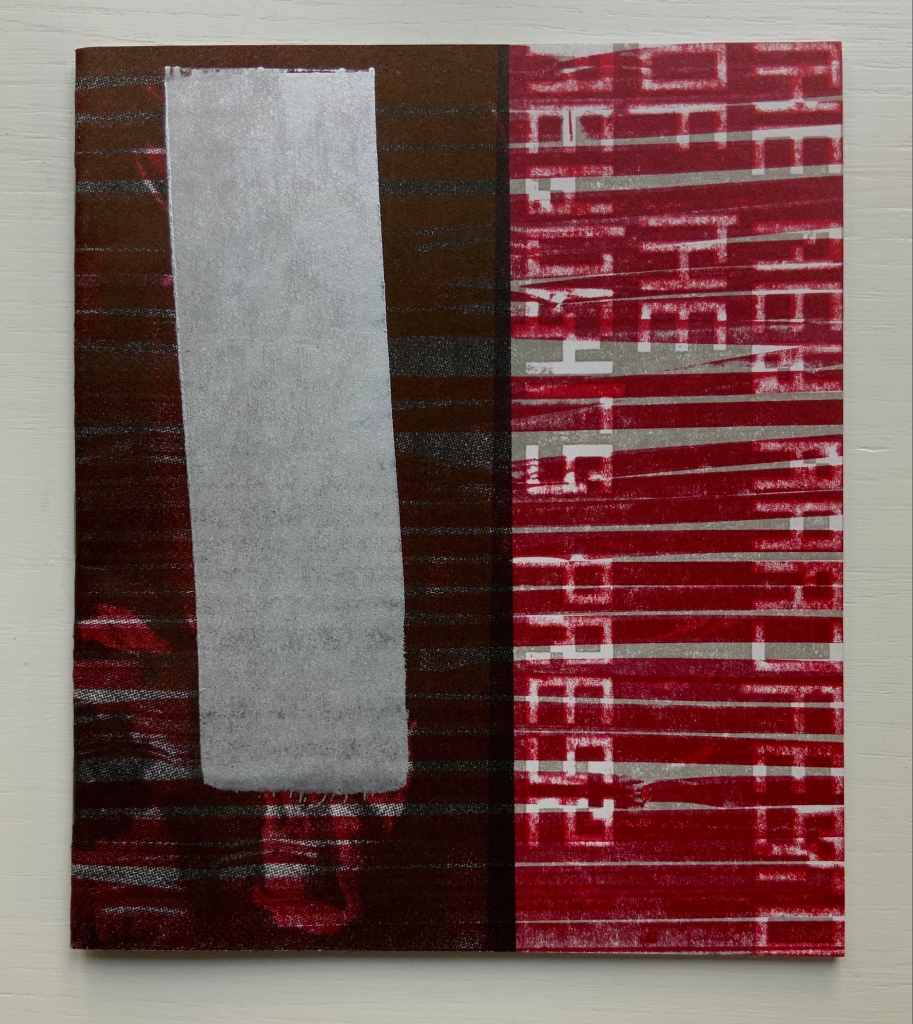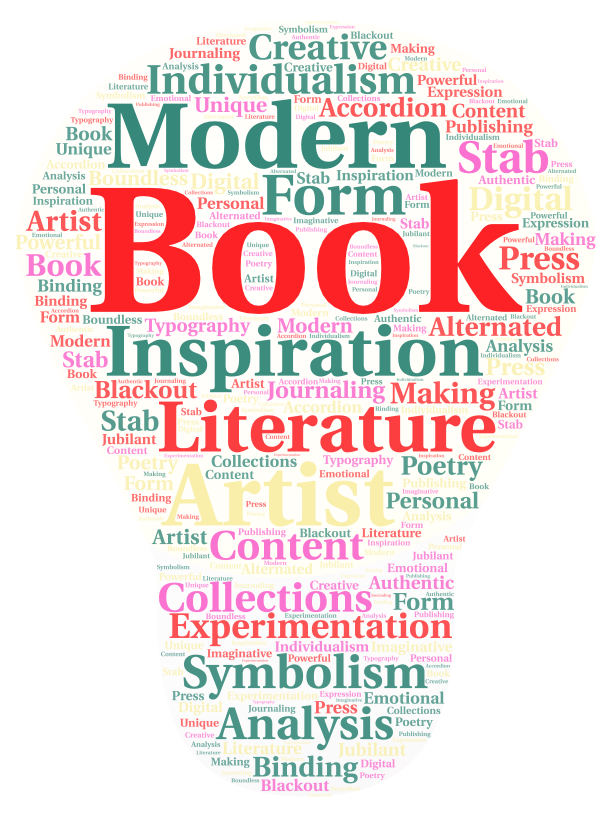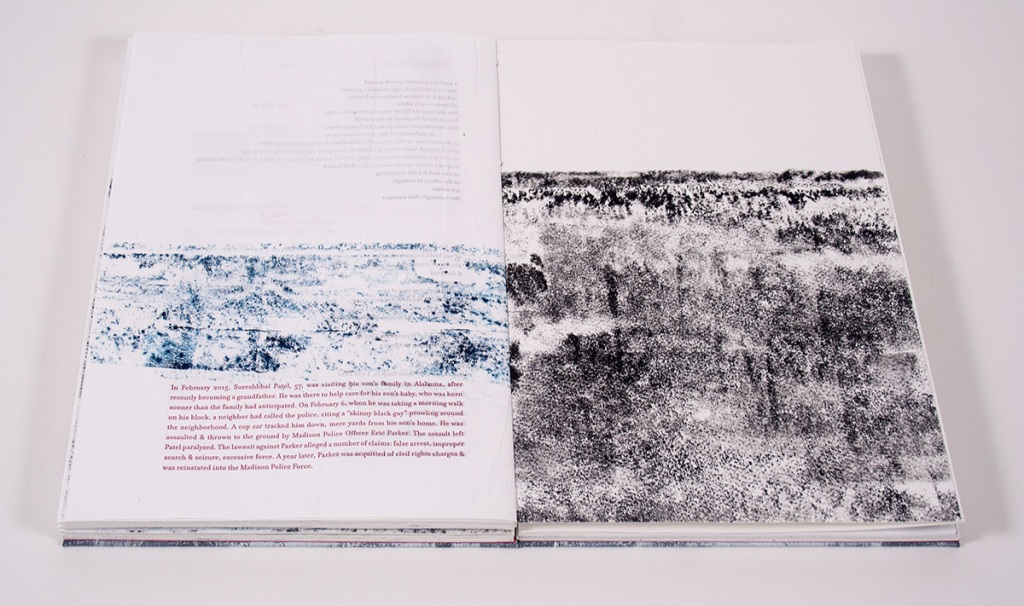Aaron Cohick, the founder of NewLights Press, was one of several artists Kyle Schlesinger interviewed in A Poetics of the Press. One of the most prominent characteristics that continue to draw me back to Cohick’s’ interview was how he portrays an open-minded and barrier-defining mindset towards his work.
CURB: A series of poems by Divya Victor that were designed and printed by Aaron Cohick which document the assaults and murders of Indian Americans and Indian Immigrants in public spaces in the United States.

Books on Books Collection: The New Manifesto of the NewLights Press (third iteration) 2017. This booklet features saddle stapling, risograph, letterpress/collagraph, and hand panting’s. [This photo is a part of Aaron Cohick’s collection titled Books on Books Collection and was acquired from NewLights Press in December 2020.]
The New Manifesto of the NewLights Press (third iteration) has multiple starting points. In fact, there are ten refinements on these starting points, and each iteration even has a diagram and footnotes which emphasize the academic nature of the starting points.
In further researching Aaron Cohick, I discovered that his personal aesthetics expand far beyond the average publisher and printer-his approach is simply authentic, primarily due to its inspiring design. One of the most fascinating components of Cohick’s work is his continuous reiteration of the idea that ‘the new is always an extension of the old and these media grow together and extend each other’ (Schlesinger 320). In addition, Cohick’s contention that the roles and trajectories of print and books in culture are changing, thus making it an exciting time to be involved in this world, is perhaps the most prominent factor that attracted me to his work. I find Cohick’s aesthetics to be an exceptionally unique agent to the evolving world of print and literature. His work is particularly inspirational due to his ‘real’ and ‘relatable’ responses to the ordinary learner about the relationship of the many working parts of modern-day publishing and printing. In A Poetics of the Press, Cohick concludes his interview by reflecting on how this is the time to be making work that is part of the living culture-subject to and dependent upon change for its vitality because print is only dead if we try to freeze it in time (Schlesinger 321). This analogy is something that I will carry with me for the rest of my career as a writer.

Aaron Cohick’s approach to publishing, in addition to the realm of the book’s form and content, truly defies traditional barriers. As founder of NewLights Press, he provides a space for independent printers and publishers to work at the intersection of artists’ books and encourages learners to experiment with text, images, and the making process. Cohick’s mission connects to the nature and transformation of the evolving world of print and literature by inspiring new and young writers to explore the relationships of the many different working parts of modern-day publishing and printing. I chose to experiment with different digital arts that ultimately connect art and form to the prospects of my creative writing response-which was fueled by inspiration from Aaron Cohick and his NewLights Press. I do not have much experience with the style or structure of digital art, but I thought it might be valuable to experiment with this new and creative process. There is an ongoing debate about whether or not digital art replaces traditional practices, but I do not see it that way. Instead, I believe traditional applications of the book’s form and content are more valuable than newer digital forms. Traditional styles connect the author with their work in ways that digital applications just cannot. However, it is necessary to recognize that while digital techniques and modes are becoming increasingly popular in publishing, this does not indicate an end to traditional practices. Cohick does an excellent job at recognizing this by stating that print is only dead if we try to freeze it in time.
Works Cited
Schlesinger, Kyle. A Poetics of the Press: Interviews with Poets, Printers & Publishers. Aaron Cohick NewLights Press, Cuneiform Press & Ugly Duckling Presse, 2021.
Cohick, Aaron. “CURB.” The Press at Colorado College, Apr. 2019, http://www.thepressatcoloradocollege.org/curb. Accessed 1 Nov. 2021.
Cohick, Aaron. “Books on Books Collection.” NewLights Press, 18 June 2021, books-on-books.com/2021/06/18/books-on-books-collection-aaron-cohick/. Accessed 1 Nov. 2021.




“Print is only dead if we try to freeze it in time”. There is something to be said about adapting the old into the new, mixing mediums, if you will. I think you show that things can adapt and change, but adaptation and change is what allows the old things to survive.
LikeLiked by 1 person
His work is so artsy and abstract looking; you can tell there’s a lot of thought and time that went into the making of each of his books! It’s neat that he encourages experimentation, especially since I think it’s too easy for people to get stuck in a rut of following what’s “right” or “traditional”. While I know that digital versus traditional art can be a whole debate, I agree with your statement! It’s really important to know where you started and where the art form began, and digital is simply an extension of the original concept; you’d have never gotten to the digital era if it weren’t first for the traditional work behind it.
LikeLiked by 1 person
I really enjoyed your discussion here, your firm and well reasoned stand for the (ongoing, if not increasing) value of traditional methods of printing. Does your word cloud’s shape represent anything to you? To me it looks like a lightbulb or a maybe a keyhole…but I could be wrong!
LikeLike